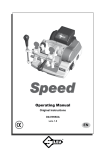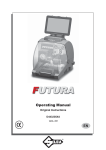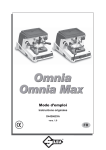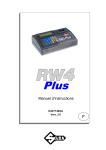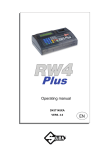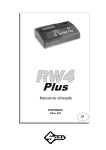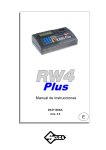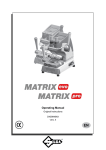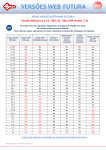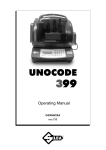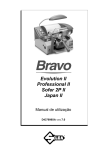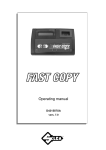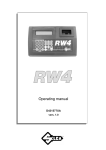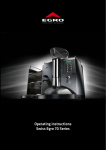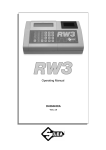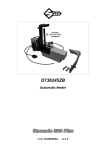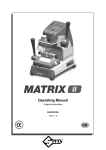Download Operating Manual EN
Transcript
Operating Manual Original Instructions D442661XA vers. 1.0 EN © 2013 SILCA S.p.A - Vittorio Veneto This manual has been drawn up by SILCA S.p.a. All rights reserved. No part of this publication can be reproduced or circulated by any means whatsoever (photocopies, microfilm or other) without the consent of SILCA S.p.A. Edition: november 2013 Printed at Vittorio Veneto by SILCA S.p.A. Via Podgora, 20 (Z.I.) 31029 VITTORIO VENETO (TV) - Italy The Manufacturer declines any responsibility for possible inaccuracies in this document due to printing or transcription errors. The Manufacturer reserves the right to alter the information without prior notice, except when they affect safety. This document or any of its parts cannot be copied, altered or reproduced without written authorization from the Manufacturer. Keep the manual and look after it for the entire life cycle of the machine. The information has been drawn up by the manufacturer in his own language (Italian) to provide users with the necessary indications to use the key-cutting machine independently, economically and safely. IMPORTANT NOTE: in compliance with current regulations relating to industrial property, we hereby state that the trade-marks or trade names mentioned in our documentation are the exclusive property of authorized manufacturers of locks and users. Said trade-marks or trade names are nominated only for the purposes of information so that any lock for which our keys are made can be rapidly identified. INDEX USE OF THE MANUAL ....................................................................................................................... 1 TERMINOLOGY .................................................................................................................................. 2 GENERAL WARNINGS ....................................................................................................................... 4 1 MACHINE DESCRIPTION....................................................................................................................6 1.1 OMNIA: main working parts ........................................................................................................7 1.2 OMNIA MAX: main working parts ...............................................................................................8 1.2.1 OMNIA MAX: Clamp carriage for VERTICAL CUTS .........................................................9 2 MAIN CHARACTERISTICS ................................................................................................................10 3 ACCESSORIES PROVIDED ..............................................................................................................13 4 Technical Data ....................................................................................................................................14 4.1 Electrical diagram .....................................................................................................................14 5 TRANSPORT ......................................................................................................................................15 5.1 Packing .....................................................................................................................................15 5.2 Pack opening ............................................................................................................................15 5.3 Unpacking .................................................................................................................................16 5.4 Removing the stop ....................................................................................................................18 5.5 Separate parts .........................................................................................................................18 5.5.1 Power cable ....................................................................................................................18 5.5.2 Warning label ................................................................................................................18 5.5.3 Carriage levers ................................................................................................................19 5.5.4 OMNIA: standard carriage (bit, double bit and pump keys) ............................................19 5.5.5 OMNIA MAX: carriage for bit, double bit and pump keys ................................................20 5.5.6 OMNIA MAX: clamp carriage for vertical cuts .................................................................20 5.5.7 OMNIA MAX: solution with a SINGLE CARRIAGE .........................................................21 5.6 Removing the clamp carriage ...................................................................................................22 6 MACHINE INSTALLATION AND PREPARATION ..............................................................................23 6.1 Checking for demage ................................................................................................................23 6.2 Environmental conditions ..........................................................................................................23 6.3 Positioning ...............................................................................................................................23 6.4 Description of work station .......................................................................................................23 6.5 Connection to the mains ...........................................................................................................23 7 MACHINE REGULATION AND UTILIZATION ....................................................................................24 7.1 Micrometric tracer point ............................................................................................................24 7.2 Tracer point spring ....................................................................................................................24 7.3 Using the tilting clamp (carriage for bit/double bit and pump keys) ..........................................25 7.4 Locking Y axis ...........................................................................................................................25 7.5 Checking and calibration...........................................................................................................26 7.5.1 Axis calibration - carriage for bit, double bit and pump keys ...........................................26 7.5.2 Axis calibration - clamp carriage for vertical cuts (Omnia MAX) .....................................27 7.5.3 Depth calibration - Carriage for bit, double bit and pump keys .......................................28 8 CUTTING OPERATIONS ...................................................................................................................30 8.1 Cutting bit and double bit keys ..................................................................................................31 8.1.1 Cutting short keys ...........................................................................................................32 8.2 Cutting double female bit keys ..................................................................................................33 8.3 Cutting keys with centre stop ....................................................................................................34 8.4 Cutting bit keys with rear stop (Omnia MAX) ............................................................................35 8.5 Cutting pump keys ....................................................................................................................36 8.6 Cutting keys with vertical cuts (Omnia MAX carriage for vertical cuts) .....................................37 9 MAINTENANCE..................................................................................................................................38 9.1 Replacing the carriage .............................................................................................................38 9.2 Replacing the tracer point ........................................................................................................38 9.3 Replacing the cutter ..................................................................................................................39 9.4 Replacing the brush ..................................................................................................................39 9.5 Replacing the fuses ..................................................................................................................40 9.6 Accessing the bottom compartment..........................................................................................40 9.7 Replacing the ON/OFF switch .................................................................................................41 9.8 Replacing the motor start button ...............................................................................................41 9.9 Replacing the reset switch ........................................................................................................42 9.10 Replacing the microswitch ........................................................................................................42 9.11 Replacing the brush button .......................................................................................................43 9.12 Replacing the plug/socket/filter .................................................................................................44 9.13 Replacing the relay ..................................................................................................................44 9.14 Replacing the lamp power box..................................................................................................45 9.15 Replacing the motor condenser ................................................................................................45 9.16 Replacing the Plexiglas shield .................................................................................................46 9.17 Replacing the lamp ...................................................................................................................47 9.18 Replacing and/or tightening the belt .........................................................................................48 9.19 Replacing the motor ..................................................................................................................49 10 DISPOSING OF MACHINE ................................................................................................................51 11 ASSISTANCE .....................................................................................................................................52 11.1 How to request service .............................................................................................................52 OMNIA - OMNIA MAX Operating Manual USE OF THE MANUAL This manual has been drawn up by the Manufacturer and is an integral part of the machine literature. The manual gives information it is obligatory for the operator to know and which makes it possible to use the machine safely. User’s Manual This user’s manual is provided because it is essential for proper use and maintenance of the machine. The manual must be kept carefully throughout the life of the machine, including the decommissioning stage. Keep in a dry place close to the machine where it is always to hand for the operator. ATTENTION: IT IS OBLIGATORY to read the manual carefully before using the machine. Readers’ characteristics This manual must be read and its contents acquired by those who will use it. The OMNIA key-cutting machine is designed for professional use by adults of either gender in full possession of their physical, sensorial or mental capacities. Manufacturer’s ID OMNIA has an ID plate located on the back of the machine, showing the serial number. Fig.1 (*) see chap. 10 DISPOSING OF MACHINE. How to apply for after-sales service Silca provides purchasers of OMNIA with After-Sales Service. For the total safety of the operator and machine, any operation not described in the manual must be carried out by the manufacturer or in the special Service Centres recommended by Silca. At the end of the manual there is a list of manufacturers’ and authorized Service Centre addresses. The warranty card attached to the machine covers free repairs or replacement of faulty parts for 24 months from the date of purchase*. All operations must be agreed by the user with Silca or the Service Centre. * Damage caused by negligence or wrong use of the machine by the user will null the warranty. Copyright Silca 2013 1 OMNIA - OMNIA MAX Operating Manual TERMINOLOGY For those inexperienced in the subject of keys and key cutting, below is an illustration of the most frequently used terms: Keys with rear stops and keys with vertical cuts: STANDARD with OMNIA MAX Fig.2 1) Head 2) Stem 2 3) Tip 4) Bit 5) Stop 6) Side Copyright Silca 2013 7) Cuts 8) Vertical cuts OMNIA - OMNIA MAX Operating Manual GRAPHICS IN THE USER’S MANUAL Obligation to read the manual Pay attention Using ear protection QR Code * GRAPHICS ON THE OMNIA and OMNIA MAX KEY-CUTTING MACHINES Obligatory use of safety goggles Obligation to read the manual Adhesive label Mass - RPM - Fusibles Motor start push button symbol Brush button symbol QR Code * Adhesive label DANGEROUS MOBILE PARTS (provided - chap.3) (*) A QR code is a two dimensional bar code used to memorize information to be read by means of a mobile phone or smart phone. Read the QR code on the machine to connect to useful and constantly updated information relating to key-cutting machine maintenance, useful tips for your OMNIA/OMNIA MAX key-cutting machine and see the continuously evolving range of optional accessories. Copyright Silca 2013 3 OMNIA - OMNIA MAX Operating Manual GENERAL WARNINGS OMNIA is designed to the principles of European Standards (CE). Right from the design stage solutions have been adopted to eliminate hazards for the operator in all the stages of use: handling, regulation, use and maintenance. The materials used in manufacture and the components employed in using OMNIA are not dangerous and ensure that the machine complies to current standards. Silca S.p.A. has also experimented and applied numerous technical solutions that allow the key-cutting machine to optimize the quality of the cut keys. To guarantee maintaining these results over time, please follow the instructions below: • Observe the procedures described in this manual; • Always use Original Silca Tools as they are designed to make the best of OMNIA and provide quality key-cutting; • Use Silca key blanks, made with top quality materials; • Have the key-cutting machine checked periodically by an authorized Silca After-Sales Service Centre (list at the end of this manual); • Always use Silca Original Spare Parts. Beware of imitations! ATTENTION: in the event of prolonged use, cutting extra thick bits or keys in hard materials (iron, steel) we recommend using individual ear protection devices. NORMAL USE OMNIA is a key-cutting machine (see chap.1) and must be installed and used according to the rules and specifications established by the manufacturer. The OMNIA key-cutting machine is designed for use on business or industrial premises (e.g. hardware shops, key cutting centres, etc...). Any other use different from that indicated in this manual will cause the forfeiture of all customers’ rights to make claims on Silca S.p.A. and may be an unknown source of hazard for the operator or third parties. ATTENTION: Negligent use or failure by the operator to observe the instructions in this manual are not covered by the warranty and the manufacturer declines any responsibility in such cases. SAFETY The key-cutting machine is built entirely to standards. The operations for which it has been designed are easily carried out at no risk to the operator. The adoption of general safety precautions (wearing protective goggles) and observation of the instructions provided by the manufacturer in this manual eliminate all human error, unless deliberate. The key-cutting machine is designed with features which make it completely safe in all its parts. • CUTTER MOTOR PROTECTION ATTENTION: the cutter motor is protected from overheating by a device (inside the motor) that stops it whenit reaches a dangerous temperature. This condition can occur when the machine motor is left on continuously (protection will cut in after approximately 40 minutes), with high ambient temperatures or in severe working conditions (considering an average work cycle - duty cycle 85% - protection will cut in after approximately 1 hr 40 minutes). If the cutter motor overheats it cuts outautomatically. In such cases proceed as follows: a) turn off the master switch (A). b) let the motor cool for at least 2 hours then use the machine normally. 4 Copyright Silca 2013 OMNIA - OMNIA MAX Operating Manual • MOTOR START PUSH BUTTON The machine is protected from untimely machine start. When the carriage is all the way back towards the operator a safety microswitch turns off the motor. If the carriage is inadvertently moved towards the cutter the motor does not start. To start the motor (with the machine on) move the carriage slightly towards the cutter and press the motor start button (B). RESIDUAL RISKS No further risks will arise when properly using the OMNIA and OMNIA MAX machines. SAFETY REGULATIONS • Always disconnect the machine when it is not in use or when performing maintenance operations. • Check the electrical wiring periodically; replace any wires that show signs of wear. • Always work with dry hands free of grease or oil. • Never tug on the electricity supply lead and make sure it is not in contact with oil or other liquids, sharp objects or heat. Never remove the earthing pin from the plug. Check that the earthing wire is connected properly. • Do not use the machine in dangerous environments (wet or damp). • All visitors, especially children, must stay at a safe distance from the machine and must never come into contact with the electric wiring. • Place the adhesive label provided “DANGEROUS MOBILE PARTS” as shown in chap.5.5.2. Copyright Silca 2013 5 OMNIA - OMNIA MAX Operating Manual 1 MACHINE DESCRIPTION OMNIA is a professional key-cutting machine for bit, male and female* double bit, and pump keys. OMNIA STANDARD (*) It is advisable to use optional accessories for female bit and double bit keys. Fig.3 OMNIA MAX is a professional key-cutting machine for bit, male and female* double bit keys and pump keys with vertical cuts. OMNIA MAX STANDARD with carriage for bit, double bit and pump keys (*) It is advisable to use optional accessories for female bit and double bit keys. Fig.4 6 Copyright Silca 2013 STANDARD with carriage for vertical cuts OMNIA - OMNIA MAX Operating Manual 1.1 OMNIA: main working parts Fig.5 A - ON/OFF switch A1 - power supply socket with fuses B - motor start button C - cutter D - tracer point D1 - tracer point spring cam D2 - micrometric ring nut for tracer point regulation E - clamp carriage F - clamp carriage locking handle G - Y axis locking knob H - motor L - translation lever M - fixed clamp for bit, double bit and pump keys M1 - mobile clamp for bit, double bit and pump keys P - fixed clamp tightening handle P1 - mobile clamp tightening handle Q - mobile clamp locking lever R - mobile clamp rotation lever S - plexiglas safety shield S1 - cover T - lamps U - brush U1 - brush push button V - swarf tray Copyright Silca 2013 Fig.6 7 OMNIA - OMNIA MAX Operating Manual 1.2 OMNIA MAX: main working parts Fig.7 A - ON/OFF switch A1 - power supply socket with fuses B - motor start button C - cutter D - tracer point D1 - tracer point spring cam D2 - micrometric ring nut for tracer point regulation E - clamp carriage F - clamp carriage locking handle G - Y axis locking knob H - motor L - translation lever M - fixed clamp for bit, double bit and pump keys M1 - mobile clamp for bit, double bit and pump keys P - fixed clamp tightening handle P1 - mobile clamp tightening handle Q - mobile clamp locking lever R - mobile clamp rotation lever S - Plexiglas safety shield S1 - cover T - lamps U - brush U1 - brush push button V - swarf tray Z - pin/gauge for keys with rear stop 8 Copyright Silca 2013 Fig.8 OMNIA - OMNIA MAX Operating Manual 1.2.1 OMNIA MAX: Clamp carriage for VERTICAL CUTS Fig.9 J - fixed clamp for vertical cuts J1 - mobile clamp for vertical cuts K - fixed clamp knob K1 - mobile clamp knob N - mobile clamp lever Copyright Silca 2013 9 OMNIA - OMNIA MAX Operating Manual 2 MAIN CHARACTERISTICS • ON/OFF SWITCH The key-cutting machine is connected to a power supply socket with a differential switch; when the machine is turned on with the switch (A) located on the right-hand side, the lamps (T) illuminate to indicate that the machine is live. ATTENTION: switch (A) is electromagnetic and if there is a power failure it goes off automatically. When power returns it must be reset manually to supply the machine with electricity. • MOTOR START BUTTON The push button (B) for starting the motor is located on the front of the machine. To start the motor (with the machine on) move the carriage slightly towards the cutter and press the motor start button (B). The machine is protected from untimely machine start. When the carriage is all the way back towards the operator a safety microswitch turns off the motor. If the carriage is inadvertently moved towards the cutter the motor does not start. • BRUSH PUSH BUTTON The push button (U1) for activating the brush is located on the front of the machine. • BRUSH The brush (U) is in accident-proof material and its purpose is to eliminate the burrs from the key after cutting. Press push button (U1) to activate the brush. • Y AXIS LOCKING KNOB The Y axis locking knob (G) is located on the front of the machine (see chap.7.4). • MACHINE CARRIAGE MOVEMENT LEVER The lever (L) has an ergonomic grip and moves on ball joints that allow smooth movement of the carriage, which has ball bearing guides. • ILLUMINATION The work area is perfectly illuminated by two fixed lamps (LED) (T) turned on by the master switch. • MICROMETRIC TRACER POINT (SPRUNG) The tracer point (D) used for reading the cuts on keys to be copied is located on the left-hand side of the machine. Depth is easily adjusted by means of the micrometric ring nut (D2) (chap.7.1). The spring function is activated/deactivated by turning the special cam (D1) (chap.7.2). • CUTTER The cutter (C) used for cutting key blanks is in TiN coated Super Rapid steel and protected by a safety shield (S). • SWARF TRAY The tray (V) located on the left is easily removable so that all the swarf can be cleared away. • MOTOR AND TRANSMISSION UNIT The motor has belt transmission. The transmission shaft that moves the cutter (C) and brush (U) is located on the right of the motor. • CLAMP HANDLES AND KNOBS Anatomical handles and knobs ensure perfect easy hold on the keys in the clamps even with just light pressure when closing them. 10 Copyright Silca 2013 OMNIA - OMNIA MAX Operating Manual • CLAMP CARRIAGES OMNIA Clamps for bit/double bit and pump keys The clamps (M) (M1) comprise two self-centring jaws which ensure perfect hold on the shafts of bit/double bit and pump keys (Fig.3). Fig.10 The carriage is found in the machine packing as a separate item (see chap.5.2 and chap.5.5). Copyright Silca 2013 11 OMNIA - OMNIA MAX Operating Manual OMNIA MAX Clamps for bit/double bit and pump keys The clamps (M) (M1) comprise two self-centring jaws which ensure perfect hold on the shafts of bit/double bit and pump keys (Fig.4). Fig.11 The carriage is found in the machine packing as a separate item (see chap.5.2 and chap.5.5). NOTE: the Omnia MAX carriage for double bit keys can be used alone or connected to the Omnia MAX carriage for vertical cuts (see chap5.5.7 OMNIA MAX: solution with a SINGLE CARRIAGE). Clamps for vertical cuts (Omnia MAX only) The clamps (J) (J1) are designed to ensure perfect hold on the shafts of bit keys with vertical cuts. Fig.12 The carriage is found in the machine packing as a separate item (see chap.5.2 and chap.5.5). NOTE: the Omnia MAX carriage for vertical cuts can be used alone or connected to the Omnia MAX carriage for bit keys (see chap.5.5.7 OMNIA MAX: solution with a SINGLE CARRIAGE). 12 Copyright Silca 2013 OMNIA - OMNIA MAX Operating Manual 3 ACCESSORIES PROVIDED OMNIA comes with a set of accessories for its operation and maintenance (tools, hex wrenches, fuses) supplied in a special tool kit comprising: allen key 2 mm spanner 13 mm allen key 2,5 mm spanner 19 mm allen key 3 mm cutter release rod allen key 4 mm fuses 1,6 Amp delayed (230V) allen key 5 mm setting pins allen key 6 mm stop pins for FIAM keys adhesive label “DANGEROUS MOBILE PARTS” connection plate+screws for the carriages (chap.5.5.7) (Omnia MAX only) (chap.5.5.2) carriage stopper (chap.5.4) Copyright Silca 2013 13 OMNIA - OMNIA MAX Operating Manual 4 TECHNICAL DATA Electricity supply: 230V - 50Hz Maximum absorbed power: 230V: 1 Amp. 235 Watt Cutter motor: single phase and speed Movements: by ball guides (carriage) and ball socket joint (lever) Cutter: 80 x 1,5 x 22 in TiN coated Super Rapid steel Tool speed: 386 rpm Runs carriages: 53 mm X axis - 42 mm Y axis (50 mm Z axis for vertical cuts carriage only) Dimensions: width: 395 mm - depth: 550 mm - height: 320 mm Mass: Kg. 32 Omnia - Kg.33,5 Omnia MAX with 2 carriages Noise level: sound pressure Lp(A) = brass 83,7 dB(A) - iron 91,7 dB(A) sound power Lw(A) = iron keys 92,1 dB(A) 4.1 Electrical diagram The main parts of the electrical circuit on the OMNIA key-cutting machine are listed below: 1) Power socket with fuses 2) ON/OFF switch 3) Lamp power 4) LED lamps 5) Carriage microswitch 6) Brush push button 7) Electromagnetic switch (reset) 8) 12.5 mF condenser 9) 230V-50Hz motor 10) Relay Fig.13 14 Copyright Silca 2013 OMNIA - OMNIA MAX Operating Manual 5 TRANSPORT The key-cutting machine transports easily and there are no particular hazards involved in handling it. The packed machine must be carried manually by 2 (or more) people or with a transpallet truck. 5.1 Packing • • • • • The packing used for the OMNIA machines guarantees protection for the machine and all its parts during transport. The packing comprises a pallet base (b), to which the machine is fixed, and a cardboard cover (a). The machine is fixed to the base with screwed brackets that stop it from moving during transport. Once the packing case is closed it is taped with two straps which secure the cardboard cover to the pallet. Warnings to observe during transport are shown by symbols on the outside of the cardboard cover. Fig.14 Keep dry Handle with care This side up Use no hooks To avoid knocks which could damage the machine, it is advisable to use the original packing and fix the machine with the special brackets every time it is transported. 5.2 Pack opening 1) Cut the straps with scissors and remove. 2) Raise the cardboard. 3) Check the contents of the box, which should comprise: OMNIA OMNIA MAX 1 Omnia key-cutting machine 1 Omnia MAX key-cutting machine 1 set of documents, including: operating manual, quick guide, spare parts list and guarantee 1 set of documents, including: operating manual, quick guide, spare parts list and guarantee 1 power cable 1 tool set 1 Omnia standard carriage 1 lever 1 power cable 1 tool set 1 Omnia MAX carriage for bit/double bit keys 1 Omnia MAX vertical cuts carriage 2 levers NOTE: the complete packing (cardboard, pallet, brackets and screws) should be kept for use whenever the machine is moved. Copyright Silca 2013 15 OMNIA - OMNIA MAX Operating Manual 5.3 Unpacking 1) Follow the instructions illustrated to remove the carriage fixing brackets and the carriage from the pallet (2 carriages on Omnia MAX): OMNIA OMNIA MAX 1 1 2 2 3 3 Fig.15 16 Fig.16 Copyright Silca 2013 OMNIA - OMNIA MAX Operating Manual 2) Remove the key-cutting machine from the pallet: 4 Fig.17 NOTE: the complete packing (cardboard, pallet, brackets and screws) should be kept for use whenever the machine is moved. ATTENTION: lift the machine by gripping the external rib on the base (Fig.18). Never lift it by holding the clamps, levers or other parts. When the key-cutting machine has been removed from its packing, place it directly on a worktop; this should be done by at least 2 persons. 5 Fig.18 Copyright Silca 2013 17 OMNIA - OMNIA MAX Operating Manual 5.4 Removing the stop 1) Loosen and remove the screw (E1). 2) Insert the stopper (E3) provided - chap.3) into the hole on the carriage. Fig.19 5.5 Separate parts The parts separate from the machine and separately packed must be installed by the operator as follows: 5.5.1 Power cable Connect power cable to the key-cutting machine (Fig.20). Fig.20 5.5.2 Warning label Place the adhesive label in the appropriate language in position as shown in Fig.21. Provided (chap.3) Fig.21 18 Copyright Silca 2013 OMNIA - OMNIA MAX Operating Manual 5.5.3 Carriage levers Screw the levers indicated in Fig.22 and Fig.23 all the way in. OMNIA OMNIA MAX Standard carriage (bit, double bit and pump keys) Carriage for bit, double bit and pump keys Fig.22 Clamp carriage for vertical cuts Fig.23 5.5.4 OMNIA: standard carriage (bit, double bit and pump keys) 1) Insert the carriage from right to left in the special groove and take to the end of its . 2) Lock the carriage with the handle (F). Fig.24 Copyright Silca 2013 19 OMNIA - OMNIA MAX Operating Manual 5.5.5 OMNIA MAX: carriage for bit, double bit and pump keys 1) Insert the carriage from left to right in the special groove and take to the end of its run. 2) Lock the carriage with the handle (F). Fig.25 5.5.6 OMNIA MAX: clamp carriage for vertical cuts 1) Insert the carriage from right to left in the special groove and take to the end of its run. 2) Lock the carriage with the handle (F). Fig.26 20 Copyright Silca 2013 OMNIA - OMNIA MAX Operating Manual 5.5.7 OMNIA MAX: solution with a SINGLE CARRIAGE Use the connecting plate and screw set provided with the key-cutting machine and follow the instructions below: 1 2 3 4 5 Copyright Silca 2013 21 OMNIA - OMNIA MAX Operating Manual 6 7 5.6 Removing the clamp carriage OMNIA: 1) Turn off the machine. 2) Loosen the handle (F) and pull out the clamp carriage to the right. 3) To fit the clamp carriage see chap. 5.5.4. OMNIA MAX: 1) Turn off the machine. With clamp carriage for bit, double bit and pump keys: 1) Loosen the handle (F) and pull out the clamp carriage to the left. 2) To fit the standard clamp carriage see chap. 5.5.5. With clamp carriage for vertical cuts: 1) Loosen the handle (F) and pull out the clamp carriage to the right. 2) To fit the vertical cuts clamp carriage see chap.5.5.6. With double carriage: 1) Loosen the handle (F) and move the carriage (double) slightly to the right. 2) Loosen and remove the screw (E2) 3) Pull out the clamp carriage to the left. 4) To fit the double clamp carriage see chap.5.5.7. 22 Copyright Silca 2013 OMNIA - OMNIA MAX Operating Manual 6 MACHINE INSTALLATION AND PREPARATION The key-cutting machine can be installed by the purchaser and does not require any special skills. It is supplied ready for use and does not need any special set up. However, the operator may have to control a few things before operating the machine. 6.1 Checking for damage OMNIA is solid and compact and will not normally damage if transport, unpacking and installation have all been carried out according to the instructions in this manual. However, it is always advisable to check that the machine has not suffered any damage. 6.2 Environmental conditions To ensure that the best use is made of the key-cutting machine, it is important to place it in a well-aired area which is not too damp. The ideal conditions for the machine are: - temperature between 10°C and 40°C; relative humidity: 60% approx. 6.3 Positioning 1) Place the machine on a horizontal surface, solid enough to support the weight (32 Kg). - to work with ease, we suggest that the workbench be approximately the height of the operator’s hip. - we recommend leaving a clearance of at least 10 cm behind the machine and 30 cm on each side to ensure good ventilation and facilitate handling (Fig. 27). 2) Ensure that the machines voltage is the same as that of the mains power supply, which must be properly earthed and provided with a differential switch. 3) Connect the power supply cable to the power supply socket. Fig. 27 6.4 Description of work station The machine needs only one operator, who has all the controls at his/her disposal (see chap.1.1 OMNIA: main working parts, chap.1.2 OMNIA MAX: main working parts and chap.1.2.1): 6.5 Connection to the mains For the safety of the operator and the machine it is important to ensure that the machine is connected to the proper mains voltage by means of an earthed differential switch. Copyright Silca 2013 23 OMNIA - OMNIA MAX Operating Manual 7 MACHINE REGULATION AND UTILIZATION To get the most out of your key-cutting machine, check gauging periodically. ATTENTION: before regulating the machine, turn it off and remove the plug. 7.1 Micrometric tracer point The use of a micrometric tracer point on a machine for cutting bit and pump keys not only provides perfect fast readings, but also rapidly resolves all those small depth variations needed when worn keys are involved. NOTE: every notch on the micrometric ring nut corresponds to a movement of 0,05 mm. Fig.28 7.2 Tracer point spring The spring function facilitates the search for spaces with the tracer point before the cutter makes the cuts. • To enable the tracer point spring: Turn the cam (D1) to the left (Fig.29). • To disable the tracer point spring: Turn the cam (D1) to the right (Fig.30). Fig.29 - spring ENABLED 24 Fig.30 - spring DISABLED Copyright Silca 2013 OMNIA - OMNIA MAX Operating Manual 7.3 Using the tilting clamp (carriage for bit/double bit and pump keys) Fig.31 Use the lever (Q) to lock the right-hand clamp (M1) in the horizontal position for calibration and cutting operations on pump keys and those with a centre stop. Lower the lever (Q) to release the right-hand clamp (M1), which activates oscillation to cut bit/double bit keys (rounding cuts off). 7.4 Locking Y axis The Y axis locking function is useful when positioning certain bit and double bit keys (especially short ones). It is also used to operate successfully on heavy duty cuts using the carriage for vertical cuts (chap.8.6). To lock or release the Y axis, turn the knob (G) clockwise or anticlockwise. Fig.32 Copyright Silca 2013 25 OMNIA - OMNIA MAX Operating Manual 7.5 Checking and calibration The cutting tool on the machine is the part used to cut the key blanks and should be periodically checked and replaced, if necessary. Every time the cutting tool is changed, and during periodical operational tests, check calibration. The OMNIA key-cutting machine requires two types of calibration: AXIS and DEPTH. Fig.33 7.5.1 Axis calibration - carriage for bit, double bit and pump keys Axis calibration is used to adjust the cutting space on the key. Axis calibration is fixed and established when the key-cutting machine is being assembled. Axis calibration control: 1) Turn off the machine and unplug. 2) Use lever (Q) to lock the right-hand clamp in the horizontal position. 3) Close the 2 clamps with their handles (P) and (P1). 4) Disable the tracer point spring by turning the cam (D1) (chap.7.2). 5) Use the lever (L) to take the stops (Y) against the right-hand side of the tracer point and cutter. The ideal condition is achieved when the internal part of the left-hand stop is up against the right-hand side of the tracer point and the internal part of the right-hand stop is in contact with the right-hand side of the cutter. If this condition is not achieved, contact Silca After-Sales Service. Fig.34 26 Copyright Silca 2013 OMNIA - OMNIA MAX Operating Manual 7.5.2 Axis calibration - clamp carriage for vertical cuts (Omnia MAX) If a clamp is replaced or has imperfections the clamp inter-axis for vertical cuts can be adjusted. 1) Turn off the machine and unplug. 2) Loosen the clamp knobs, push the clamps forward and insert the calibration pin into the key shaft groove (to the right or left of each clamp.) 3) With the machine off take the carriage up to the cutter and tracer point so that it rests against the 2 calibration pins (sideways). 4) When the tracer point is in contact with the side of the calibration pin the cutter should skim the side of the corresponding pin. If not: - loosen the 2 upper screws (J2) fixing the fixed clamp and the 2 rear screws (J3). - regulate the grub screw (K3) to achieve the optimum condition. - tighten the 2 screws (J2) and the 2 screws (J3). Fig.35 Fig.36 Fig.37 Copyright Silca 2013 27 OMNIA - OMNIA MAX Operating Manual 7.5.3 Depth calibration - Carriage for bit, double bit and pump keys Depth calibration is used to adjust the depths of cuts. Depth calibration should be checked periodically to ensure perfect machine efficiency, and whenever the cutter or tracer point is replaced. Depth calibration control: 1) Turn off the machine and unplug. 2) Use the lever (Q) to lock the right-hand clamp in the horizontal position. 3) Place the calibration pins (provided) in place on the clamps. 4) Disable the tracer point spring with cam (D1) (chap.7.2). 5) Move the carriage and take the calibration pins into contact with the tracer point and cutter. 6) Fit a hex key into the brush screw (Fig. 38). Turn the brush clockwise manually and check that the cutter skims the calibration pin in a number of points. 7) If necessary, use the tracer point to adjust cutting depths as follows: - turn the ring nut (D2) clockwise to move the tracer point forward (less deep cut) (Fig.40). - turn the ring nut (D2) anticlockwise to move the tracer point back (deeper cut) (Fig.41). 8) Repeat these operations until the cutter skims the calibration pin in a number of points. NOTE: every notch corresponds to a movement of 0.05 mm. Fig. 38 Fig.39 28 Copyright Silca 2013 OMNIA - OMNIA MAX Operating Manual Fig.40 Turning the ring nut to the RIGHT (clockwise) moves the tracer point towards the operator. Result: LESS DEEP CUTS. Fig.41 Turning the right nut to the LEFT (anticlockwise) moves the tracer point forward. Result: DEEPER CUTS. Copyright Silca 2013 29 OMNIA - OMNIA MAX Operating Manual 8 CUTTING OPERATIONS ATTENTION: for complete safety during the cutting operations, take the following precautions: • Start the motor only after completing the operations on the carriage (securing the keys, etc..).. • Always work with dry hands. • Check that the machine is properly earthed. • Wear protective goggles even if the machine has a protective shield. • Keep hands away from the cutting tool in motion. ATTENTION: the machine is protected from inadvertent motor start. When the carriage is all the way back towards the operator a microswitch turns off the motor. If the carriage is inadvertently moved towards the cutter the motor does not start. ATTENTION: the Y axis lock function is useful to facilitate positioning certain bit/double bit keys and cutting with the vertical cuts clamp. Turn the knob (G) clockwise or anticlockwise to lock or release the Y axis (chap.7.4). ATTENTION: in the event of prolonged use, cutting extra thick bits or keys in hard materials (iron, steel) we recommend using individual ear protection devices. 30 Copyright Silca 2013 OMNIA - OMNIA MAX Operating Manual 8.1 Cutting bit and double bit keys 1) Use the lever (Q) to lock the right-hand clamp in the horizontal position. 2) Fit the keys into the clamps (original key in the left-hand clamp and key blank in the right-hand clamp) with the bit up against the stop (Y). 3) Close the clamps making sure that the key shafts are in the V groove and check that the key bits are perpendicular to the tracer point and cutter (Fig.44). 4) Lower the lever (Q) to release the right-hand clamp. 5) Turn on the machine with the ON/OFF switch (A). 6) Use the lever (L) to slowly take the carriage towards the cutter and press the button (B) to start the motor. 7) Hold the lever (R) slightly raised with the key facing downwards. 8) Take the cut closest to the original key tip against the tracer point and lower the lever (R) to round off the cut. 9) Take the carriage back to come out of the cut. Move the carriage sideways and enter the next cut (Fig.45).Do not move sideways once into the cut. 10) Complete all the bits in the same way and remove any excess material at the end of the cutting operation (towards the head). 11) Take the carriage all the way back (the motor will stop automatically). 12) For double bit keys, turn both keys over and repeat the operations described above. 13) When the cutting operation is finished, take the carriage all the way back (the motor will stop automatically) and remove the keys. Fig.42 Fig.43 Fig.44 Copyright Silca 2013 Fig.45 31 OMNIA - OMNIA MAX Operating Manual 8.1.1 Cutting short keys If the keys to be cut are very short and do not touch the stop (Y) proceed as follows, observing the illustration. 1) Use the lever (Q) to lock the right-hand clamp in the horizontal position. 2) Lock the key blank into the right-hand clamp (M1) (as shown) (Fig.42). 3) Raise the carriage and place the right-hand side of the bit against the cutter. Lock the carriage in this position with the knob (G). 4) Lock the original key into the left-hand clamp (M) (as shown), with the right-hand side of the bit up against the tracer point. In this way the two keys will be perfectly aligned (Fig.42). 5) Release the knob (G) and take the carriage all the way back. 6) Lower the lever (Q) to release the right-hand clamp. 7) Turn on the machine with the ON/OFF switch (A). 8) Use the lever (L) to slowly take the carriage towards the cutter and press the button (B) to start the motor. 9) Hold the lever (R) slightly raised with the key facing downwards. 10) Take the cut closest to the original key tip against the tracer point (do not apply force, remember that the key tip is not held) and lower the lever (R) to round off the cut. 11) Take the carriage back to come out of the cut. Move the carriage sideways and enter the next cut. Do not move sideways once into the cut. 12) Complete all the bits in the same way and remove any excess material at the end of the cutting operation (towards the head). 13) Take the carriage all the way back (the motor will stop automatically). 14) For double bit keys, turn both keys over and repeat the operations described above. 15) When the cutting operation is finished, take the carriage all the way back (the motor will stop automatically) and remove the keys. Fig.46 32 Copyright Silca 2013 OMNIA - OMNIA MAX Operating Manual 8.2 Cutting double female bit keys We can also use the instructions for cutting very short bit or double bit keys to cut some bit or double bit (female) keys, taking care to observe and check some dimensional and operational characteristics: Dimensional: - Maximum height of bit against stem axis = 15 mm (max) - Maximum length of bit to be cut = 17 mm (max) Operational: • Between the end of the bit (towards the key head) and the left-hand internal side of the clamp there must be a space of 2 mm (max) and no less than 1,5 mm (cutter thickness). • During cutting (especially for iron keys) do not exert too much pressure when pushing the key towards the cutter, as the key tip has nothing to butt against. NOTE: the precision of keys cut in this way will refer to the external stem diameter rather than the centre of the internal hole in the tip. Any imprecision between the hole axis and the stem is additional to the normal tolerance for manual cutting. Fig.47 It is advisable to use optional accessories for female bit and double bit keys (see OMNIA and OMNIA MAX Specialist Guide). Copyright Silca 2013 33 OMNIA - OMNIA MAX Operating Manual 8.3 Cutting keys with centre stop 1) Use the lever (Q) to lock the right-hand clamp in the horizontal position. 2) Loosen the clamp handles slightly to be able to fit the keys. 3) Fit the original key into the left-hand clamp with the centre stop up against the clamp and the bit parallel to the clamp (perpendicular to the tracer point); secure the key with the handle (P). 4) Fit the key blank into the right-hand clamp with the centre stop up against the clamp and the bit parallel to the clamp (perpendicular to the cutter); secure the key with the handle (P1). Cutting: 1) Turn on the machine with the ON/OFF switch (A). 2) Use the lever (L) to slowly take the carriage towards the cutter and press the button (B) to start the motor. 3) Take the cut closest to the original key tip against the tracer point (if required release the lever (Q) and lower the lever (R) to round off the cut). 4) Take the carriage back to come out of the cut. Move the carriage sideways and enter the next cut. Do not move sideways once into the cut. 5) Complete the bit in this way and check the sides of the bit if necessary. 6) When the cutting operation is finished, take the carriage all the way back (the motor will stop automatically) and remove the keys. Fig.48 34 Copyright Silca 2013 OMNIA - OMNIA MAX Operating Manual 8.4 Cutting bit keys with rear stop (Omnia MAX) The Omnia MAX clamp carriage for bit/double bit keys has a pin/gauge set (Z) on the left-hand part of each clamp for positioning keys with rear stops. The pin can change position by moving from right to left, or vice versa. The length of the pin has small grooves along it to provide the operator with the following indications: • sound, when the ball presser enters one of these positions/ grooves (a click is heard); • visual, to position the keys on the same notch. The 2 pinsgauges (Z) must show the same number of clicks/grooves. 1) Use the lever (Q) to lock the right-hand clamp in the horizontal position. 2) Fit the keys into the clamps, moving them to the right until the rear stop goes up against the (Z) (Fig.50). The spacing on the gauge set (Z) must be the same for both clamps ( a = b ). Fig. 49 3) 4) 5) 6) 7) 8) 9) Secure the keys with the handles (P) and P1). Lower the lever (Q) to release the right-hand clamp. Turn the machine on with the ON/OFF switch . Use the lever (L) to slowly take the carriage towards the cutter and press the button (B) to start the motor. Hold the lever (R) slightly raised with the key facing downwards. Take the cut closest to the original key tip against the tracer point and lower the lever (R) to round off the cut. Take the carriage back to come out of the cut. Move the carriage sideways and enter the next cut. Do not move sideways once into the cut. 10) Complete the bit in this way and remove any excess material at the end of the operation (towards the head). 11) Take the carriage all the way back (the motor will stop automatically). Fig.50 Copyright Silca 2013 35 OMNIA - OMNIA MAX Operating Manual 8.5 Cutting pump keys 1) Use the lever (Q) to lock the right-hand clamp in the horizontal position. 2) Fit the original key into the left-hand clamp (M) with the bit up against the lower jaw of the clamp (Fig.52). 3) Use the special seats for pump keys: for keys with round shafts and Mottura type keys with square shafts (Fig.51). 4) Fit the key blank into the right-hand clamp (M1) in the same way. NOTE: we recommend using the tracer point spring function (chap.7.2). 5) Turn on the machine with the ON/OFF switch. 6) Use the lever (L) to slowly take the carriage towards the cutter and press the button (B) to start the motor. 7) Take the first cut on the right of the original key against the tracer point and push the carriage all the way. 8) Take the carriage back to come out of the cut. Move the carriage sideways and enter the next cut. Do not move sideways once into the cut. 9) Complete all the bits in the same way and if necessary check the sides of the bits. 10) When the cutting operation is finished, take the carriage all the way back (the motor will stop automatically) and remove the keys. Fig.51 Fig.52 36 Copyright Silca 2013 OMNIA - OMNIA MAX Operating Manual 8.6 Cutting keys with vertical cuts (Omnia MAX carriage for vertical cuts) The keys can be placed with the bit on the left or right, according to the position of the groove to be turned towards the tracer point and cutter. 1) Loosen the knob (K) and push forward to fit the original key (with the head upwards) into its seat on the fixed clamp (J). Take the bit up against the clamp stop and secure the key with the knob (K). 2) Loosen the knob (K1) and push forward to fit the key blank (with the head upwards) into its seat on the mobile clamp (J1). Take the bit up against the clamp stop and secure the key with the knob (K1). NOTE: we recommend using the tracer point spring function (chap.7.2). NOTE: we recommend using the Y axis carriage lock function (chap.7.4) for very thick keys or keys in particularly hard material. 3) 4) 5) 6) Turn on the machine with the ON/OFF switch (A). Use the lever (L) to slowly take the carriage towards the cutter and press the button (B) to start the motor. Enter the vertical cut/groove on the original key with the tracer point (press firmly against the tracer point). Use the lever (N) to move the mobile clamp (J1) from bottom to top. Take the carriage back to come out of the cut. Move the carriage sideways and, if applicable, enter the next groove to complete cutting the key. Do not move sideways once into the cut. 7) When the cutting operation is finished, take the carriage all the way back (the motor will stop automatically) and remove the keys. Fig.53 Fig.54 Fig.55 Copyright Silca 2013 37 OMNIA - OMNIA MAX Operating Manual 9 MAINTENANCE ATTENTION: for repairs or replacement of parts for maintenance, the ‘CE’ mark is guaranteed only if original spare parts provided by the manufacturer are used. Although the key-cutting machine does not require special maintenance, it is advisable to check and, if necessary, replace the parts subject to wear, such as: the belt, cutting tool, brush, tracer point. Replacement is simple and can be carried out by the operator. CLEANING Keep the carriage and clamps free of chippings from the cutting operations by cleaning with a dry brush. ATTENTION: do not use compressed air! ATTENTION: to keep the machine well maintained we recommend using protective oil, e.g. WD40 or similar, applied to the burnished mechanical parts. This prevents oxidation of the parts in question (clamps, guides, carriages...). Before starting any type of maintenance (checks or replacements), read the instructions below: • Never carry out maintenance or servicing with the machine switched on. • Always remove the mains plug. • Follow all the instructions in the manual to the letter. • Use original spare parts. • Always check that any screws or nuts removed when replacing a piece are properly tightened. 9.1 Replacing the carriage ATTENTION: turn off the machine and unplug. To remove and install the carriage see the instructions in chap.5.6 and chapters 5.5.4, 5.5.5, 5.5.6 and 5.5.7. 1) Fit the new carriage into the dovetail seat and slide all the way up to the limit switch. Secure by tightening the handle (F). 2) Check machine calibration (chap.7.5). 9.2 Replacing the tracer point Proceed as follows to replace the tracer point (D): ATTENTION: turn off the machine and unplug. 1) 2) 3) 4) 5) 6) Enable the tracer point spring function (chap.7.2). Loosen the screw (D3). Remove the worn tracer point. Fit the new tracer point, pushing all the way in. Tighten the screw (D3). Check depth calibration as described in chap.7.5.3. Fig. 56 38 Copyright Silca 2013 OMNIA - OMNIA MAX Operating Manual 9.3 Replacing the cutter ATTENTION: turn off the machine and unplug. 1) Remove the carriage (chap.5.6). 2) Slot the locking rod (provided) into the hole of the cutter shaft (Fig.57 and Fig.58). 3) Use the spanner provided to loosen the cutter locking nut. ATTENTION: the thread is left-handed. 1) Remove the worn cutter. 2) Carefully clean the new cutter and its seat. 3) Install the new cutting tool and tighten the nut. ATTENTION: the tool rotates clockwise. 4) Remove the locking rod. 5) Re-position the carriage and check depth calibration as described in chap.7.5.3. Fig.57 Fig.58 9.4 Replacing the brush ATTENTION: turn off the machine and unplug. 1) Remove or move the carriage (chap.5.6). 2) Slot the locking rod (provided) into the hole of the cutting tool shaft (Fig.57). 3) Use the Allen key to loosen the screw (U2) and remove the brush (Fig. 59). 4) Replace the brush and tighten the screw (U2) with the Allen key. Fig. 59 Copyright Silca 2013 39 OMNIA - OMNIA MAX Operating Manual 9.5 Replacing the fuses Fuses should be checked with a tester (ohmmeter, multimeter, etc.) as they may appear to be in good condition even when they are electrically faulty. Fuses must always be replaced with the same amperage and type (rapid or delayed), as indicated in this manual. The OMNIA key-cutting machine has 2 fuses placed in the inlet socket to protect the key-cutting machine from sudden changes in voltage or short circuits. 1) Turn the machine off and unplug it from its power supply cable. 2) Use a screwdriver to open the fuse plate in the power socket. ATTENTION: fuses must always be replaced with others of the same type (delayed) and with the same Amps (1,6 Ampere). Fig.60 9.6 Accessing the bottom compartment ATTENTION: turn off the machine and unplug. 1) 2) 3) 4) 5) 6) Remove the swarf tray (V) (Fig.61). Remove the clamp carriage (chap.5.6). Remove the mat and any objects on the upper cover. Place the machine on its left-hand side. Loosen and remove the 4 feet (V1). Loosen the 2 screws (X1) and remove the bottom cover (X). Fig.61 40 Fig.62 Copyright Silca 2013 OMNIA - OMNIA MAX Operating Manual 9.7 Replacing the ON/OFF switch ATTENTION: turn off the machine and unplug. 1) 2) 3) 4) 5) 6) 7) Gain access to the bottom compartment (chap.9.6). Disconnect the 4 connectors (A5) (A6) from the switch, observing their position carefully (Fig.64). Press the fixing tabs on the switch so that it can be pulled out. Fit the new switch into its seat. Re-connect the 4 connectors (A5) (A6). Put the bottom cover (X) in place and secure with the screws (X1); screw in the 4 feet (V1) (Fig.62). Place the machine upright on the worktop and insert the swarf tray (V) (Fig.61). Fig.63 Fig.64 9.8 Replacing the motor start button ATTENTION: turn off the machine and unplug. 1) 2) 3) 4) Gain access to the bottom compartment (chap.9.6). Loosen the ring nut (A3) and remove the motor start button (B). Remove the push button and ring nut. Fit the new push button and tighten the ring nut (A3). Fig.65 Copyright Silca 2013 41 OMNIA - OMNIA MAX Operating Manual 9.9 Replacing the reset switch ATTENTION: turn off the machine and unplug. 1) 2) 3) 4) 5) 6) 7) 8) Gain access to the bottom compartment (chap.9.6). Loosen the ring nut (A3) and remove the motor start button (B) (Fig.65). Disconnect the 4 connectors (A4) on the switch, observing their position carefully (Fig.66). Press the fixing tabs on the switch so that it can be pulled out towards the operator. Observe its position carefully. Fit the new switch, taking care to position it properly. Re-connect the 4 connectors (A4). Place the bottom cover (X) in position, secure with the screws (X1) and screw in the 4 feet (V1) (Fig.62). Place the machine upright on the worktop and insert the swarf tray (V). Fig.66 9.10 Replacing the microswitch ATTENTION: turn off the machine and unplug. 1) 2) 3) 4) 5) 6) Gain access to the bottom compartment (chap.9.6). Disconnect the 3 connectors (c) (nc) (no) (Fig.67). Loosen the 2 support plate screws (P3) and remove. Loosen the 2 screws (R3) and 2 nuts (R4) so that the microswitch can be removed (Fig.68). Attach the new microswitch to the plate with the 2 screws (R3) and nuts (R4). Replace the plate and secure with the 2 screws (P3). When the carriage is idle (fully back towards the operator) the microswitch lever must be down. 7) Place the bottom cover (X) in position, secure with the screws (X1) and screw in the 4 feet (V1) (Fig.62). 8) Place the machine upright on the worktop and insert the swarf tray (V). 42 Copyright Silca 2013 OMNIA - OMNIA MAX Operating Manual Fig.68 Fig.67 9.11 Replacing the brush button ATTENTION: turn off the machine and unplug. 1) 2) 3) 4) 5) 6) 7) Gain access to the bottom compartment (chap.9.6). Disconnect the 2 push button connectors (U1), observing their position carefully (Fig.69). Press the fixing tabs on the switch so it can be pulled outwards. Fit the new push button into its seat. Re-connect the connectors. Place the bottom cover (X) in position, secure with the screws (X1) and screw in the 4 feet (V1) (Fig.62). Place the machine upright on the worktop and insert the swarf tray. Fig.69 Copyright Silca 2013 43 OMNIA - OMNIA MAX Operating Manual 9.12 Replacing the plug/socket/filter ATTENTION: turn off the machine and unplug. 1) Loosen the 2 screws (A2). 2) Gain access to the bottom compartment (chap.9.6). 3) Disconnect the 2 connectors (A5) from the ON/OFF switch, loosen the nuts (X3) and (X4) in order to remove the earth wire, and remove the plug (Fig.71). 4) Place the new socket in its seat with the fuse box at the bottom and secure with the 2 screws (A2). 5) Connect the 2 connectors (A5) on the new plug to the ON/OFF switch, re-connect the earth wire and tighten the nuts (X3) and (X4). 6) Place the bottom cover (X) in position, secure with the screws (X1) and screw in the 4 feet (V1) (Fig.62). 7) Place the machine upright on the worktop and insert the swarf tray (V). Fig.70 Fig.71 9.13 Replacing the relay ATTENTION: turn off the machine and unplug. 1) 2) 3) 4) 5) 6) Gain access to the bottom compartment (chap.9.6). Release the 2 engaging levers (B2) from the relay (B3). Remove the relay from its holder. Fit the new relay to its support and engage the 2 levers (B2). Place the bottom cover (X) in position, secure with the screws (X1) and screw in the 4 feet (V1) (Fig.62). Place the machine upright on the worktop and insert the swarf tray (V). Fig.72 44 Copyright Silca 2013 OMNIA - OMNIA MAX Operating Manual 9.14 Replacing the lamp power box ATTENTION: turn off the machine and unplug. 1) Gain access to the bottom compartment (chap.9.6). 2) Loosen the 4 low voltage (35V) wire fixing screws (K5), observing their position carefully. 3) Loosen the 2 power lead fixing screws (K6) (one wire in position 0 and one in the position of the voltage involved 230V). 4) Loosen the 4 power box fixing screws (K7) and remove. 5) Install and secure the new power box with the 4 screws (K7). 6) Use the screws (K5) to fix the 4 low voltage wires into the 35V connectors on the transformer, observing their position carefully. 7) Use the screws (K6) to fix the 2 power leads into the connectors on the power box (one wire in position 0 and one in the position of the voltage involved 230V). ATTENTION: observe the position of the wires according to the voltage (Fig.73). 8) Place the bottom cover (X) in position, secure with the screws (X1) and screw in the 4 feet (V1) (Fig.62). 9) Place the machine upright on the worktop and insert the swarf tray (V). Fig.73 Fig.74 9.15 Replacing the motor condenser ATTENTION: turn off the machine and unplug. 1) 2) 3) 4) 5) 6) Gain access to the bottom compartment (chap.9.6). Remove the condenser cap and disconnect the 2 connectors (C4) (Fig.75) observing their position carefully. Loosen and remove the old condenser from the machine body, and replace with a new one. Connect the 2 connectors (C4), observing their position carefully, and replace the cap on the new condenser. Place the bottom cover (X) in position, secure with the screws (X1) and screw in the 4 feet (V1) (Fig.62). Place the machine upright on the worktop and insert the swarf tray (V). Copyright Silca 2013 45 OMNIA - OMNIA MAX Operating Manual Fig.75 9.16 Replacing the Plexiglas shield ATTENTION: turn off the machine and unplug. 1) 2) 3) 4) 5) Remove the top mat. Loosen the 4 screws (S2), remove the 2 screws (S3) and remove the top cover (S1) (Fig.76). Loosen the 3 screws (S4) and remove the Plexiglas shield (S) (Fig.77). Place the new shield (S) in position and secure with the screws (S4). Secure the top cover with the 4 screws (S2) and the 2 screws (S3); replace the mat. Fig.76 46 Copyright Silca 2013 OMNIA - OMNIA MAX Operating Manual Fig.77 9.17 Replacing the lamp ATTENTION: turn off the machine and unplug. 1) 2) 3) 4) 5) 6) 7) 8) Remove the top mat. Loosen the 4 screws (S2), remove the 2 screws (S3) and remove the top cover (S1) (Fig.76). Loosen the 2 screws (T1) on the lamp support (Fig.78). Detach the connector (T3) from the lamp to be replaced. Loosen the lamp fixing screws (T4) and remove (Fig.79). Place the new lamp in position and secure with the screws (T4). Place the lamp support in position and secure with the screws (T1). Secure the top cover with the 4 screws (S2) and the 2 screws (S3); replace the mat. Fig.78 Fig.79 Copyright Silca 2013 47 OMNIA - OMNIA MAX Operating Manual 9.18 Replacing and/or tightening the belt ATTENTION: turn off the machine and unplug. 1) Remove the top mat. 2) Loosen the 4 screws (S2), remove the 2 screws (S3) and remove the top cover (S1) (Fig.76). 3) Gain access to the bottom compartment (chap.9.6). • To TIGHTEN: 4) Loosen the 4 nuts (H1) (Fig.80), push the motor towards the back of the machine and then tighten the 4 nuts (H1). • To REPLACE: 5) Loosen the 4 nuts (H1) and move the motor forward towards the machine . 6) Loosen the 3 screws (S4) and remove the Plexiglas shield (Fig.77). 7) Remove the brush (chap.9.4). 8) Loosen the 3 screws (H6) and remove the belt protection (H7) (Fig.81). 9) Remove the belt (H8) and fit a new belt into the two pulleys (Fig.82). 10) Replace the belt protection (H7) and secure with the screws (H6). 11) Replace the brush. 12) Re-fit the Plexiglas shield. 13) Push the motor towards the back of the machine and tighten the 4 nuts (H1). 14) Place the bottom cover (X) in position, secure with the screws (X1) and screw in the 4 feet (V1) (Fig.62). 15) Place the machine upright on the worktop and insert the swarf tray (V). 16) Secure the top cover with the screws (S2) and (S3) (Fig.76); replace the mat. Fig.80 48 Copyright Silca 2013 OMNIA - OMNIA MAX Operating Manual Fig.81 Fig.82 9.19 Replacing the motor ATTENTION: turn off the machine and unplug. 1) 2) 3) 4) 5) 6) 7) 8) Remove the top mat. Loosen the 4 screws (S2), remove the 2 screws (S3) and remove the top cover (S1) (Fig.76). Loosen but do not remove the 2 grub screws (H5) fixing the motor (Fig.83). Gain access to the bottom compartment (chap.9.6). Raise the condenser cap and remove the 2 connectors (C4) (Fig.84). Loosen the nut (X3) and remove the earthing wire. Remove the fasteners on the motor wiring. Loosen the screws (1, 2, 7, 8) and disconnect the wiring from the relay (observe the right position carefully) (Fig.85). 9) Loosen and remove the 4 nuts (H1) fixing the motor (Fig.80). TAKE CARE not to drop the motor. 10) Move the motor towards the front of the machine and remove the belt from the motor pulley. 11) Slide out the motor (upwards) and remove the 4 screws (H2) (Fig.83). 12) Remove the pulley from the old motor and fit onto the new one, securing with the two grub screws (H5). 13) Place the new motor in position with the 4 screws (H2) and tighten the 4 nuts (H1) without locking them. 14) Take the motor wiring through the special hole and connect the 2 connectors (C4) to the condenser. 15) Insert the belt into the motor pulley, push the motor towards the back of the machine and lock the 4 nuts (H1). 16) Re-connect the connectors (1, 2, 7, 8) to the relay (observe the right position carefully). 17) Re-connect the earthing wire with the nut (X3). 18) Place the bottom cover (X) in position, secure with the screws (X1) and screw in the 4 feet (V1) (Fig.62). 19) Place the machine upright on the worktop and insert the swarf tray (V). 20) Secure the top cover with the screws (S2) and (S3) (Fig.76); replace the mat. Copyright Silca 2013 49 OMNIA - OMNIA MAX Operating Manual Fig.83 Fig.84 Fig.85 50 Copyright Silca 2013 OMNIA - OMNIA MAX Operating Manual 10 DISPOSING OF MACHINE EU regulations establish special arrangements for the disposal of waste (**) • Waste deriving from cutting operations The waste deriving from key cutting is classified special waste, but is still classified as solid urban waste, as metal wool. Such waste must be disposed of in special collection centres according to the classification assigned to them by the current EEC law. The circumstances which transform metal residue from solid urban waste into contaminated or toxic noxious waste are listed in the appendices to the current European Union regulations regarding disposal of such waste. • Packing The packing in which the machine is transported is made of cardboard and wood therefore can be re-used if intact or if dismantled used as combustible materials. Warning! Take great care when dismantling the packing as it contains nails, which could cause injuries. We recommend to bend the nails downwards into the wood with a hammer or to completely remove the nails disposing them in authorized metal recycling centres. The packing is considered solid urban waste and must not be thrown into the environment but placed in special cardboard collection bins. INFORMATION FOR USERS as per art. 10 of Directive 2002/96/CE of 27/01/2003 regarding waste from electric and electronic appliances (RAEE), • • • • • The symbol illustrated above, also found on the machine, indicates that it has been placed on the market and must be included in separate rubbish collection when the user wishes to dispose of it (including all components, sub-assemblies and consumables that are integrated in the product). For information about the collection system for such appliances please contact SILCA S.p.A. or another subject registered in the various National Rolls for other countries in the European Union. Household waste (or of similar origin) can be included in the separate collection system for urban waste. On purchasing a new appliance of equivalent type, the old one can be consigned to the dealer. The dealer will then contact whoever is responsible for collecting the appliance. Suitable separate collection of the unused appliance and its dispatch for treatment, recovery and environmentally compatible disposal, makes it possible to avoid potential negative effects on the environment and human health, and aids recycling and the recovery of the materials used. Unauthorised disposal of the product by users involves the application of the sanctions provided for in received Directives 91/156/CE and 91/689/CE. (**) Waste is any substance or object deriving from human activity or natural cycles, disposed off or to be disposed off. Copyright Silca 2013 51 OMNIA - OMNIA MAX Operating Manual 11 ASSISTANCE Silca provides full assistance to purchasers of the key-cutting machine. To ensure complete safety for the operator, any job not specified in this manual should be carried out by the manufacturer or in the special Service Centres recommended by Silca. On the back cover of this manual is a list of the manufacturer’s addresses; listed below are the addresses of specialised Service Centres. 11.1 How to request service The guarantee attached to the key-cutting machines ensures free repairs or replacements of faulty parts within 24 months of purchase. All other service calls must be arranged by the customer with Silca or with a Silca service centre. 52 Copyright Silca 2013 VITTORIO VENETO 30/10/2013 CE DECLARATION OF MACHINE COMPLIANCE SILCA S.p.A. - VIA PODGORA 20 ( Z.I.) 31029 VITTORIO VENETO (TV) - (ITALY) TEL. 0438 9136 - FAX. 0438 913800 Declares under its own responsibility that the Key-cutting machine model OMNIA complies with the requirements of the following European Directives: European Union DIRECTIVE 2006/42/CE (Machines) and with the EN 12100 – 1 :2010 Standards European Union DIRECTIVE 2004/108/CE (Electromagnetic Compatibility) and with the EN 55022 : 2010 / EN 55024 : 2010 EN 61000 – 3 – 2 : 2006 + A1 + A2 : 2009 EN 61000 – 3 – 3 : 2008 Standards | 13 | European Union DIRECTIVE 2006/95/CE (Low Voltage) and with the EN 60950 – 1 : 2006 + A11 : 2009 + A1 : 2010 + A12 : 2011 EN 62233 : 2008 Standards Claudio Tomasella of the Silca S.p.A. Research & Development Division is authorized to create a Technical File. General Manager Basic Production Center VITTORIO VENETO 30/10/2013 CE DECLARATION OF MACHINE COMPLIANCE SILCA S.p.A. - VIA PODGORA 20 ( Z.I.) 31029 VITTORIO VENETO (TV) - (ITALY) TEL. 0438 9136 - FAX. 0438 913800 Declares under its own responsibility that the Key-cutting machine model OMNIA MAX complies with the requirements of the following European Directives: European Union DIRECTIVE 2006/42/CE (Machines) and with the EN 12100 – 1 :2010 Standards European Union DIRECTIVE 2004/108/CE (Electromagnetic Compatibility) and with the EN 55022 : 2010 / EN 55024 : 2010 EN 61000 – 3 – 2 : 2006 + A1 + A2 : 2009 EN 61000 – 3 – 3 : 2008 Standards | 13 | European Union DIRECTIVE 2006/95/CE (Low Voltage) and with the EN 60950 – 1 : 2006 + A11 : 2009 + A1 : 2010 + A12 : 2011 EN 62233 : 2008 Standards Claudio Tomasella of the Silca S.p.A. Research & Development Division is authorized to create a Technical File. General Manager Basic Production Center SERVICE CENTERS - CENTRI DI ASSISTENZA - KUNDENDIENSTZENTREN - CENTRES D’ASSISTANCE CENTROS DE ASISTENCIA - CENTROS DE ASSISTÊNCIA - BIJSTANDSCENTRA COMPANY ADDRESS CITY AREA CODE PHONE FAX e-mail Algeria Sarl Maghreb Clés Coopérative Ettadhamoune Local 21/A Badjarah / Alger 16209 +213-21-264934 +213-21-264888 [email protected] Argentina Distribuidora Frappampino S.r.l. La Rioja, 483 Cordoba 5000 +54-351-4216368 +54-351-4229003 [email protected] Australia Locksmiths' Supply Co. Pty Ltd. 140/158 Dryburgh St. North Melbourne VIC 3051 +61-39-3297222 +61-39-3281731 [email protected] Austria Erwe Gmbh Feldgasse, 16 Feldkirchen A-9560 +43-42762816 +43-42765054 [email protected] Belgium Duitman Bvba Zinkstraat 13 Halle 1500 +32-2-3831620 +32-2-3831622 [email protected] Kaba Do Brasil Ltda. Rua Guilherme Asbahr Neto 510 São Paulo 04646001 +55-11-5545-4510 +55-11-5545-4515 [email protected] Bulgaria Intesa S.r.l. 1, Kukush Sofia 01309 +359-2-8211425 +359-2-8211347 [email protected] Burkina Faso Diallo Mamoudou Av.Houari Boumedienne Porte N. 1651 01BP / 2957 Ouagadougou 01 +226-710448 +226-710002 [email protected] Silca China Xinhua Industrial Zone Guanghai County, Taishan, Canton +86-750-5325698 +86-750-5315655 [email protected] Colombia Flexon Llaves S.A. Av.Carrera 70 No.99 - 55 Entrada 1 Bogotà +571-2538300 +571-5331842 Croatia Ferrotechna d.o.o. Japodska, 66c Pula +385-52-503-529 +385-52-502-609 +385-52-503-529 [email protected] Cyprus G.H. Yacoubian Ltd. 74/B, Regaena Street Nicosia +357-22-663525 +357-22-669009 [email protected] Czech Republic H&B Plus. s.r.o. Zatecká, 8 Plzen 30148 +420-377-225903 +420-377-225904 [email protected] Denmark Agenturcentret A.S Brydehusvej 20 Ballerup 2750 +45-70111211 +45-70111221 [email protected] Gam Transworld 23 Omer Ibn El-Khatar Street Heliopolis El Cairo +20-2-22404705 +20-2-26441401 +20-2-22404705 [email protected] Finland Hardware Group Finland Oy. (Hgf Ltd) Luostarinportti 5 Kirkkonummi 02400 +358-9-2219490 +358-9-2962186 [email protected] France SILCA S.A.S. 12, Rue de Rouen B.P.37 Z.I. Limay Porcheville 78440 +33-1-30983500 +33-1-30983501 [email protected] Germany SILCA GmbH Siemensstrasse, 33 Velbert 42551 +49-2051-2710 +49-2051-271172 [email protected] Greece Chrisikos K. Ioannhs 7 Pipsou St. Thessalonik TK 54627 +30-2310-510336 +30-2310-521651 [email protected] Greece F. Sotiropoulos & Son O.E. Patission Str., 110 Athens 11257 +30-210-8234009 +30-210-8238480 [email protected] Greece GEMKA-Karidis G. & Sons OE Lykoyrgoy St. 14-16 Athens 10552 +30-210-3243000 +30-210-3249571 [email protected] Greece Fr.lli Raptakis Pili Iisou 10 Iraklion - Crete +30-2810-285000 +30-2810-280165 [email protected] Guinea Soguintec S.A. Calle Abilio Baloboa Malabo - Provincia del Bioko Norte +240-556618 Holland Duitman B.V. Aquamarijnstraat 5 7554 NM - Hengelo +31-74-2452520 +31-74-2452522 [email protected] Holland H. Cillekens & Zn. B.V. Metaalweg, 4 JB Roermond 6045 +31-475-325147 +31-475-325148 [email protected] Holland Steenhauer B.V. Oude Raadhuisstraat 1 Ap Leidschendam 2266 +31-70-3177262 +31-70-3177333 [email protected] Professional Lock Centre Co. Ltd. Unit A-D, 9/F. Gemstar Tower, 23 Man Lock Street Hunghom, Kowloon, Hong Kong +852-23302268 +852-23302082 [email protected] Kaba Elzett Megyeri út 51 Budapest 1044 +36-1-3501011 +36-1-3290692 [email protected] India Minda Silca Engineering Ltd. Plot No. 37, Toy City Greater Noida 201308 +91-987-397630 +91-987-397631 +91-120-2351301 [email protected] Iran Klidavarshayan Co. No.73 Stakhr. St - Emam Khomaini Ave. Tehran +98-216-6702757 +98-216-735649 [email protected] Israel A.M.C.I. Locksmith Supply Ltd. 22 Efal Street Kiryat Aryeh P.O.Box 3667 Petah Tikva 49130 +972-3-9230331 +972-3-9230332 [email protected] Italy SILCA S.p.A. Via Podgora, 20 (Z.I.) Vittorio Veneto - TV 31029 +39-0438-9136 +39-0438-913800 [email protected] Japan Clover Co. Ltd 1-2-40 Haradanaka, Toyonaka-shi Osaka 5610807 +81-6-6844-2111 +81-6-6844-1147 [email protected] COUNTRY Brazil China Egypt Hong Kong Hungary 52100 COUNTRY COMPANY ADDRESS CITY Kenya MPPS Ltd. P.O. Box 31347 Nairobi Kuwait Hasawi & Sabano Co. For Gen.Trad. P.O. Box 42105 Kuwait City Latvia Solo F Ltd. Salaspils 12 Riga Lebanon Mouawad Books & Stationary Sarl. Mouawad Str. Mouawad Center, 60094 Jal el Dib Beyrouth Macedonia Panevski & Sinovi Llidenska , 11 Kumanovo Unimark Ltd. 32, Zerafa Str. Hmr 03 Marsa Corporacion Cerrajera Alba Sa De Cv Circuito Gustavo BAZ, 16 Atizapan de Zaragoza Messico D.F. Davel Importacao Comercio e Servicos Rua Do Carmo NR.54 - 3° Solat New Zealand Baber LSC Limited Nigeria AREA CODE PHONE FAX e-mail +254-20-6532913 +254-20-6533370 +254-20-6533369 [email protected] 70652 +965-24832505 +965-2622778 [email protected] 1057 +371-7278359 +371-7876901 [email protected] +961-4-711202 +961-4-11206 [email protected] +389-31-411545 +389-31-412411 [email protected] +356-21-231540 +356-241319 [email protected] 52966 +52-55-53667200 +52-55-53667291 [email protected] Coimbra 3000 +351 239833858 +351 914506747 Unit 5, 6 Argus Place Auckland Glenfield 1310 +649-444-5117 +649-444-5119 [email protected] Chilex Security Products Ltd. 12, Olowu Street P.O. Box 5153 Ikeja - Lagos +234-1-4965005 +234-1-4965005 [email protected] Norway Prodib Ab Montorgat 16 Eskilstuna 632 29 +46-16-168000 +46-16-145590 [email protected] Poland Dar-Mar ul. Napoleona, 17 Kobylka 05-230 +48-22-7710118 +48-22-7710118 [email protected] Poland Z.P.U.H. Expres Wojcieck Kowalczyk 32-447 Siepraw 795 Siepraw +48-1227-46365 +48-1227-46365 [email protected] Portugal Casa Das Chaves Da Falagueira Ltda Estrada Da Falagueira 5B Amadora 2701 +351-214936430 +351-214912403 [email protected] Portugal Luso Chav' Av. Rodrigues de Freitas, 199-A Porto 4000303 +351-22-5104702 +351-22-5361248 [email protected] Romania M&C Business S.r.l. 36, Badea Cartan Street 2nd District Bucharest 20064 +40-213118602 +40-212120155 [email protected] Russia Strazh 16/2, pt. Komsomolskiy Moscow 119021 +7 495 7083440 +7-495-7083292 Russia O.O.O. Peter Key Mihaylovsky Pereulok, 7b Saint Petersburg 198095 +7-812-2520241 +7-812-2523885 [email protected] Saudi Arabia Fahd Omar Bamashmous Est. P.O. Box 20919 Jeddah 21465 +966-2-6422588 +966-2-6447238 [email protected] Serbia Silkon D.O.O. 29, Novembra 70 Belgrade 11000 +381-11-2080200 +381-11-3290017 [email protected] Singapore Silca Soxxi Pte. Ltd. 21 Toh Guan Rd. East #01-12 Toh Guan Centre Singapore 608609 +65-6316-8100 +65-6316-4470 [email protected] Slovakia H&B Slovakia s.r.o. Ovsistske Nam. 1 Bratislava 85104 +421-2-6252-0032 +421-2-6252-0033 +421-2-6252-0034 [email protected] South Africa Sanlic International (Pty) Ltd. 46, Hulbert Street New Centre Johannesburg +27-11-4939717 +27-11-6831312 [email protected] Spain Silca Key Systems S.A. C/Santander 73/A Barcelona 08020 +34-93-4981400 +34-93-2788004 [email protected] Prodib Ab Montorgat 16 Eskilstuna 632 29 +46-16-168000 +46-16-145590 [email protected] Robert Rieffel Ag Widenholzstrasse 8 Wallisellen 8304 +41-44-8773333 +41-44-8773322 [email protected] Muheiddin Arabi Katbi P.O. Box 1322 Damascus +963-11-2212407 +963-11-2224588 +963-11-2224588 +963-11-3737001 Taiwan Global Tecspro Ltd. 11F-2 N.42-2 Lian Sheng St. Jhongho City Taipei +886-2-22494028 +886-2-22425735 [email protected] Turkey Kadiköy Anahtar San.Ve.Tic.Ltd.Sti. Osmanaja Mah.Nüzhet Efendi Sk.No.56 Kadiköy - Istanbul +90-216-4145254 +90-216-3475488 [email protected] U.A.E. Sabano Trading Co.Llc P.O. Box 32075 Dubai +971-4-2682400 +971-4-2622778 [email protected] Service-Centre Kopir Segedskaya 12 Odessa 65009 +38-487-433196 +38-487-190777 [email protected] SILCA Ltd. 6 Lloyds Court Manor Royal Crawley RH10 9QU +44-1293-531134 +44-1293-531108 [email protected] Kaba Ilco Corp. 400 Jeffreys Road, P.O. Box 2627 Rocky Mount NC 27804 +1-252-446-3321 +1-252-446-4702 [email protected] Venezuela La Casa del Cerrajero C.A. Av. Principal de Maripérez Caracas +58-212-793-0083 +58-212-781-8692 [email protected] Yemen Sabano Trading Co.Llc P.O. Box 32075 Dubai U.A.E. +971-4-2682400 +971-4-2622778 [email protected] Malta Mexico Mozambique Sweden Switzerland Syria Ukraine United Kingdom U.S.A. 1300 SILCA S.p.A. Via Podgora, 20 (Z.I.) 31029 VITTORIO VENETO (TV) Tel. 0438 9136 Fax 0438 913800 E-mail: [email protected] www.silca.biz Members of the Kaba Group





























































